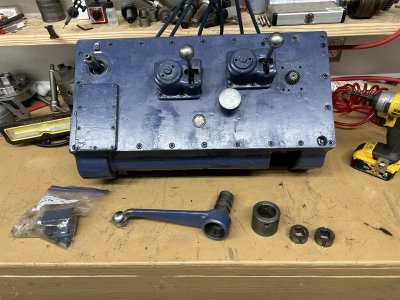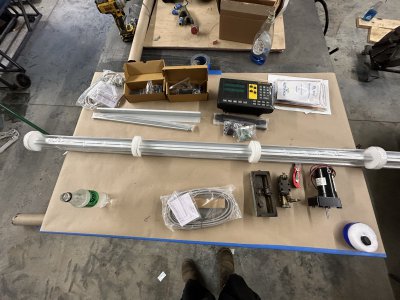- Joined
- Sep 28, 2022
- Messages
- 141
I would recommend that you throw away all the old meter valves. There are multiple layers of felt and very fine screens inside of these – and sometimes even a check valve. Even though you get them clean enough to flow oil, it won’t be long before they clog up again. The decades of old, sticky paraffin I think is the culprit.
However, I would really recommend that you consider breaking the apron and the saddle completely down. I have done this on pretty much all my lathes, and I’ve never been sorry that I did. No matter how much you clean on them or how clean the machine is, you’ll be amazed at how much dirt and crud is still in there. Additionally, I usually end up changing all the bearings in the apron while I’m at it.
You have the right equipment and the right attitude to get it done. Don’t let the complexity of the apron deter you. Just set the apron upright on one table, suspended from a crane. Then build yourself a laydown table out of a new sheet of plywood. Start at the top of the apron taking the top pieces out. As you take each piece out, reassemble them in your hand and lay them out on the plywood as they came out, numbering them as you go. I mark the board with the number. Sometimes I’ll even write notes related to the assembly on the board next to the part. It also helps to take pictures of the part and of where it came from. You continue this process going down through the apron until you reach the bottom. Eventually you’ll reach the bottom of the casting. This is where you can truly clean it up and possibly re-Glyptal it.
Take each subassembly and clean all its pieces, replace bearings as needed, and reassemble that subassembly being sure to retain the original order and orientation as laid out on the plywood table. Eventually you’ll end up with a table full of cleaned, inspected, and repaired parts. At that point you’ll have the order for reassembly (just work in reverse). By the time you clean and inspect each part, you’ll know the apron inside and out and reassembly won’t be that hard. The complexity of the apron really makes no difference.
In the end you’ll have a smoother working apron that you know is working and oiling correctly. One bit of help is that Monarch made such good quality machinery, you won’t have to fight poorly fitting parts. Besides it gives you a real appreciation of what made these so special.
One other thing, before reinstalling the saddle and apron back on the lathe, I usually assemble them together hanging from the crane and run the oil system to verify that everything is oiling as it should.
Of course you may be aware of this already. I just don’t often hear it actually explained how this is done.
I’ve included a few pictures of this process on a recently completed TOS apron as an example.
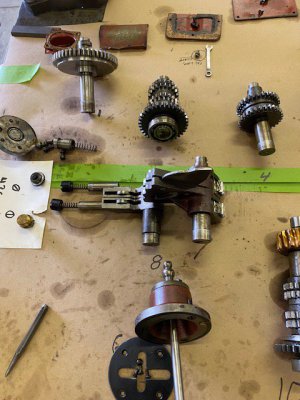
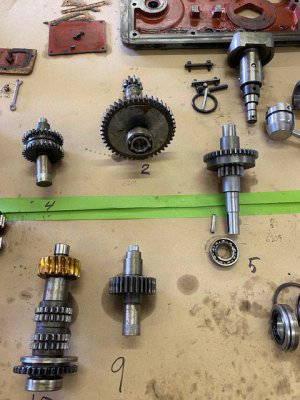
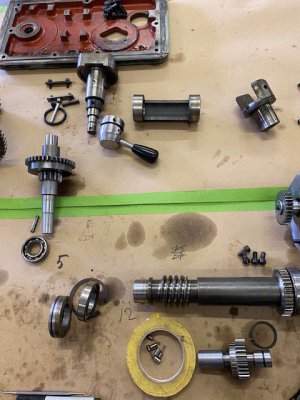
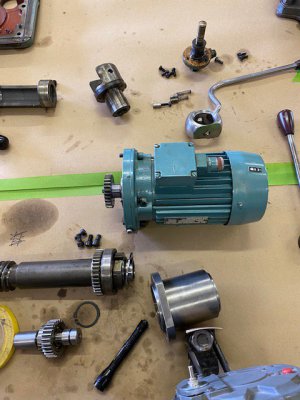
However, I would really recommend that you consider breaking the apron and the saddle completely down. I have done this on pretty much all my lathes, and I’ve never been sorry that I did. No matter how much you clean on them or how clean the machine is, you’ll be amazed at how much dirt and crud is still in there. Additionally, I usually end up changing all the bearings in the apron while I’m at it.
You have the right equipment and the right attitude to get it done. Don’t let the complexity of the apron deter you. Just set the apron upright on one table, suspended from a crane. Then build yourself a laydown table out of a new sheet of plywood. Start at the top of the apron taking the top pieces out. As you take each piece out, reassemble them in your hand and lay them out on the plywood as they came out, numbering them as you go. I mark the board with the number. Sometimes I’ll even write notes related to the assembly on the board next to the part. It also helps to take pictures of the part and of where it came from. You continue this process going down through the apron until you reach the bottom. Eventually you’ll reach the bottom of the casting. This is where you can truly clean it up and possibly re-Glyptal it.
Take each subassembly and clean all its pieces, replace bearings as needed, and reassemble that subassembly being sure to retain the original order and orientation as laid out on the plywood table. Eventually you’ll end up with a table full of cleaned, inspected, and repaired parts. At that point you’ll have the order for reassembly (just work in reverse). By the time you clean and inspect each part, you’ll know the apron inside and out and reassembly won’t be that hard. The complexity of the apron really makes no difference.
In the end you’ll have a smoother working apron that you know is working and oiling correctly. One bit of help is that Monarch made such good quality machinery, you won’t have to fight poorly fitting parts. Besides it gives you a real appreciation of what made these so special.
One other thing, before reinstalling the saddle and apron back on the lathe, I usually assemble them together hanging from the crane and run the oil system to verify that everything is oiling as it should.
Of course you may be aware of this already. I just don’t often hear it actually explained how this is done.
I’ve included a few pictures of this process on a recently completed TOS apron as an example.






